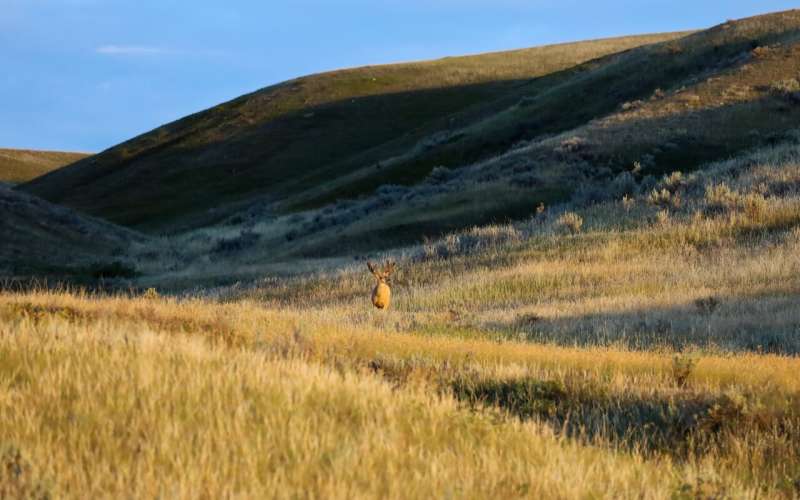This article has been reviewed according to Science X's editorial process and policies. Editors have highlighted the following attributes while ensuring the content's credibility:
fact-checked
trusted source
proofread
Natural carbon sinks could play a small but significant role in Canada's climate strategy

Canada's carbon-capturing natural areas can play a small—but effective—part in the country's overall strategy to lower greenhouse gas emissions, according to a national report including two University of Alberta experts.
The recent report from the Council of Canadian Academies assessed the potential of fully protecting, restoring or expanding Canada's forests, wetlands, grasslands and croplands. It found that not only would such nature-based climate solutions (NBCSs) result in a modest drop in annual greenhouse gas emissions, but could also have other environmental benefits.
The findings suggest there is a place for NBCSs in Canada's overall strategy to mitigate climate change, says Vic Adamowicz, an environmental economist in the Faculty of Agricultural, Life & Environmental Sciences who served on the panel along with colleague David Olefeldt.
"We have to also use other approaches to try to achieve greenhouse gas reduction, but nature-based climate solutions can play an important role."
The report, sponsored by Environment and Climate Change Canada, stemmed from the federal government's request to more fully explore the potential for enhancing carbon storage and reducing emissions through NBCSs.
The findings can help inform the federal government's commitment to cutting greenhouse gas emissions to at least 40 percent below 2005 levels by 2030, and reaching a net-zero Canadian economy by 2050.
The various benefits, limitations and costs for NBCSs in forests, freshwater systems, agricultural land, grasslands and coastal zones were analyzed by the panel, which consisted of 15 Canadian and international experts from a range of areas including climatology, ecology, agronomy, economics and Indigenous knowledge.
The report's wide scope provides "a synthesis for the country of what the options are, the uncertainties, the challenges of trying to implement some of these nature-based climate solutions," Adamowicz notes.
Among the key conclusions was that some NBCSs come with additional benefits, including better flood control, better air and water quality, higher biodiversity and property values, and lower soil erosion and urban heat island effects.
That finding shows the importance of considering the value of NBCSs beyond their costs and the ability to capture carbon, suggests Olefeldt, a wetlands scientist.
"When looking at conservation and restoration, the policy frameworks should not be just focused on the climate benefits; the consideration needs to be more holistic."
Complex challenges
There are some limitations to NBCSs, the report noted.
Fully implementing NBCSs would mitigate about six percent of Canada's current annual greenhouse gas emissions, but would also involve a variety of complex factors that need to be weighed carefully.
The report laid out cost options for various scenarios, showing that the highest mitigation potential over the next 30 years lies in preserving peatlands and grasslands and managing croplands to sequester more carbon.
But along with that, factors such as costs, policies, technical impediments and other challenges made some NBCSs more feasible than others, including income loss to resource and agricultural industries when land is set aside for preservation.
"The potential exists for nature-based climate solutions, but there are both scientific questions and feasibility of implementation," Olefeldt notes.
And while Canada's natural areas store carbon, under adverse conditions like warming temperatures or land development, they could also release greenhouse gas, adding to climate change and weakening the effectiveness of NBCSs, noted the report.
Finding feasible solutions
The panel's findings can now help the federal government weigh and identify the most promising solutions for feasible widespread use in Canada, Adamowicz says.
"They can start thinking about these challenges around implementation and evaluation, and where and how to invest in these solutions that natural systems offer."
The report also noted that integrated approaches involving the public, Indigenous communities and all levels of government would be essential to successfully leveraging natural systems.
"We're going to need some government programs, policy design, conversations with landowners and work with Indigenous communities to find our way through to programs that will deliver the carbon benefits and keep everyone comfortable with how the programs are working," Adamowicz notes.
Work on carbon sequestration using natural systems has already been happening, he adds, through various government incentive programs and the research of scientists like the U of A's Edward Bork and Cameron Carlyle.
Next steps would be to strengthen the science around measuring NBCSs, Olefeldt suggests.
"If we are to successfully implement solutions, we need to conduct more research and do more monitoring of conserved and restored sites, to verify that what we are claiming about carbon accumulation is actually happening. Right now, we don't have the data at a fine enough scale."
Policy design and evaluation will help determine "whether we are getting the carbon benefits of what we are investing in," adds Adamowicz.
"Because these are natural systems, there's much we don't yet know about them."
The report can help draw attention to the importance of Canada's natural areas as a tool in the fight against climate change, Olefeldt believes.
"This might help us take the next steps in creating new policies that are even better at helping restore and conserve wetlands and other ecosystems. Policy and public perception go hand in hand, and one allows the other."
Building up nature-based climate solutions is doable, Adamowicz adds.
"We have to do a lot of things to get to net zero, and using natural systems is one of the options; it can play a role and generate some co-benefits, so let's look at it and start choosing the ones that would work well."
More information: Nature-Based Climate Solutions: The Expert Panel on Canada's Carbon Sink Potential: cca-reports.ca/reports/canadas … rbon-sink-potential/
Provided by University of Alberta





















